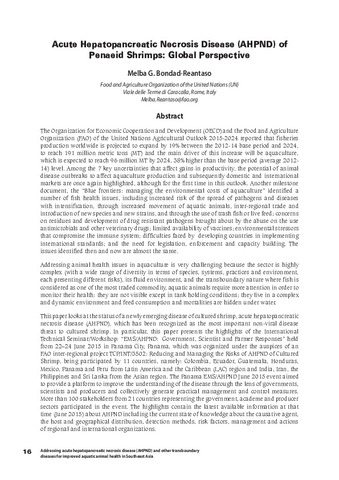Genomic analysis of Vibrio harveyi strain PH1009, a potential multi-drug resistant pathogen due to acquisition of toxin genes
| dc.contributor.author | De Mesa, Czarina Anne | |
| dc.contributor.author | Mendoza, Remilyn | |
| dc.contributor.author | Penir, Sarah Mae | |
| dc.contributor.author | dela Pena, Leobert D. | |
| dc.contributor.author | Amar, Edgar | |
| dc.contributor.author | Saloma, Cynthia | |
| dc.coverage.spatial | Masbate | en |
| dc.coverage.spatial | Philippines | en |
| dc.date.accessioned | 2023-03-28T03:12:13Z | |
| dc.date.available | 2023-03-28T03:12:13Z | |
| dc.date.issued | 2023-03-25 | |
| dc.identifier.citation | De Mesa, C. A., Mendoza, R. M., Penir, S. M. U., dela Pena, L. D., Amar, E. C., & Saloma, C. P. (2023). Genomic analysis of Vibrio harveyi strain PH1009, a potential multi-drug resistant pathogen due to acquisition of toxin genes. Heliyon, e14926. https://doi.org/10.1016/j.heliyon.2023.e14926 | en |
| dc.identifier.uri | http://hdl.handle.net/10862/6424 | |
| dc.description | The following is the Supplementary data to this article: Download .xls (8.95 MB) | en |
| dc.description.abstract | In has increasingly been observed that viral and bacterial coinfection frequently occurs among cultured shrimp and this coinfection could exacerbate the disease phenotype. Here, we describe a newly discovered bacterial strain, Vibrio harveyi PH1009 collected from Masbate Island, Philippines that was found to be co-infecting with the White Spot Syndrome virus a sample of black tiger prawn, Penaeus monodon. The genome of V. harveyi PH1009 was sequenced, assembled, and annotated. Average Nucleotide identity calculation with Vibrio harveyi strains confirmed its taxonomic identity. It is a potential multi-drug and multi-heavy metal resistant strain based on the multiple antibiotic and heavy metal resistance determinants annotated on its genome. Two prophage regions were identified in its genome. One contained genes for Zona occludens toxin (Zot) and Accessory cholera toxin (Ace), essential toxins of toxigenic V. cholerae strains apart from CTX toxins. Pan-genome analysis of V. harveyi strains, including PH1009, revealed an “open” pan-genome for V. harveyi and a core genome mainly composed of genes necessary for growth and metabolism. Phylogenetic tree based on the core genome alignment revealed that PH1009 was closest to strains QT520, CAIM 1754, and 823tez1. Published virulence factors present on the strain QT520 suggest similar pathogenicity with PH1009. However, PH1009 Zot was not found on related strains but was present in strains HENC-01 and CAIM 148. Most unique genes found in the PH1009 strain were identified as hypothetical proteins. Further annotation showed that several of these hypothetical proteins were phage transposases, integrases, and transcription regulators, implying the role of bacteriophages in the distinct genomic features of the PH1009 genome. The PH1009 genome will serve as a valuable genomic resource for comparative genomic studies and in understanding the disease mechanism of the Vibrio harveyi species. | en |
| dc.description.sponsorship | This research was funded by the Philippine Council for Agriculture, Aquatic and Natural Resources Research and Development of the Department of Science and Technology, Philippines. We acknowledge the Philippine Shrimp Pathogenomics Program members for their help in collecting, processing, and analyzing various isolates; and the Department of Science and Technology Science Education Institute for funding support to C.A.D.M. and R.M.M. | en |
| dc.language.iso | en | en |
| dc.publisher | Elsevier | en |
| dc.relation.uri | https://www.cell.com/article/S2405844023021333/pdf | en |
| dc.subject | resistance to antibiotics | en |
| dc.title | Genomic analysis of Vibrio harveyi strain PH1009, a potential multi-drug resistant pathogen due to acquisition of toxin genes | en |
| dc.type | Article | en |
| dc.identifier.doi | 10.1016/j.heliyon.2023.e14926 | |
| dc.citation.volume | 9 | |
| dc.citation.issue | 4 | |
| dc.citation.spage | e14926 | |
| dc.citation.journalTitle | Heliyon | en |
| dc.subject.asfa | genomes | en |
| dc.subject.asfa | vibriosis | en |
| dc.subject.asfa | pathogens | en |
| dc.subject.asfa | Bacteria | en |
| dc.identifier.essn | 2405-8440 | |
| dc.subject.scientificName | Vibrio harveyi | en |
| dc.subject.scientificName | Penaeus monodon | en |
| local.subject | Antibiotic resistance | en |
| local.subject | Heavy metal resistance | en |
| local.subject | Prophage | en |
| local.subject | Vibrio harveyi | en |
| local.subject | Zona occludens toxin | en |
Files in this item
| Files | Size | Format | View |
|---|---|---|---|
|
There are no files associated with this item. |
|||
This item appears in the following Collection(s)
-
Journal Articles [1215]
These papers were contributed by Department staff to various national and international journals.




